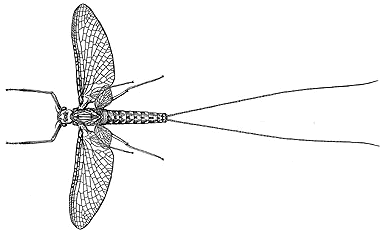 |
Order
- EPHEMEROPTERA
(Greek, ephemeros = short-lived; pteron = wing)
Common Name: mayflies
Distribution: Cosmopolitan
Description
Mayflies belong to one of the first living radiations of winged insects.
Their larvae (nymphs) are aquatic but the adults are terrestrial. The
adults have vestigial mouthparts, do not feed and typically have three,
long bristles (caudal filaments) at the apex of the abdomen. The two outer
bristles are more correctly called cerci; a long central filament may also
be present to produce the three bristles most commonly seen. Well
developed compound eyes are present together with three simple eyes (ocelli).
The adult insect has two pairs of wings; the front pair is large and well
developed, while the rear pair is much smaller. Often the forelegs are
very long, which gives the insect a characteristic "elongated"
appearance when at rest. The adult insect is remarkable for its delicacy
and fragility and is readily crushed by even gentle touches.
Naiad
Mating is accomplished during immense swarming clouds of the insects over
water. The eggs are deposited in masses directly into the water by the females.
The egg masses break apart and individual eggs disperse to the bottom mud. The
hatched mayfly larva resembles a wingless adult (a nymph) and it feeds on
plants, fungi or fine detritus; some species are carnivorous. Gills are present
as a fringe along the length of the abdomen. Nymphs grow by moulting and may
take up to three years to mature. On maturity, the nymph reaches the water
surface and moults to produce a dull-coloured subimago. This is a winged stage
but it is not yet fully adult. The subimago spends much of its time resting
although it can fly. The final moult takes place after several hours or days and
the adult insect then emerges.
Members
Mayflies.
Food
Only the juveniles feed. Most nymphs feed on detritus, bottom algae or
aquatic fungi. However, a few species are carnivorous on aquatic organisms.
Importance
Mayflies are extremely important in the ecology of freshwater streams. They
form an important food source for many other organisms. Numerous entomologists
have reported on the size of the enormous swarms of mayflies during their mating
"dances". One description comparing it to "a dense
snowstorm". As adults do not feed, their life is limited to several hours
or at most, days. Fish eat the adults in vast quantities during egg laying or
when the insects fall exhausted to the water surface.